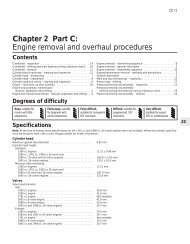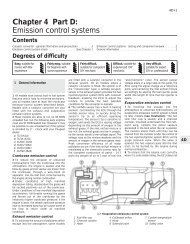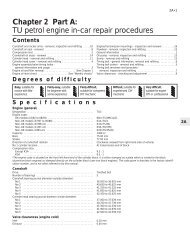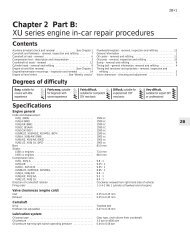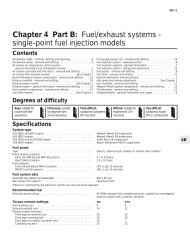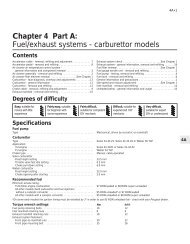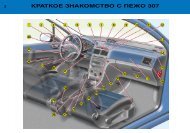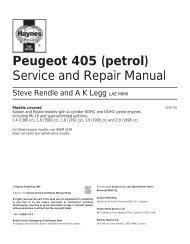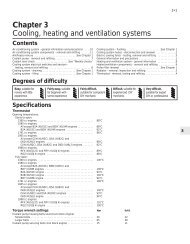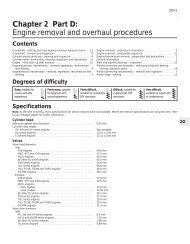Chapter 1 Routine maintenance and servicing
Chapter 1 Routine maintenance and servicing
Chapter 1 Routine maintenance and servicing
You also want an ePaper? Increase the reach of your titles
YUMPU automatically turns print PDFs into web optimized ePapers that Google loves.
12 000 Mile / 12 Month Service 1•15<br />
11.5 Pulling the HT leads<br />
from the spark plugs<br />
11.7 Tools required for spark plug<br />
removal, gap adjustment <strong>and</strong> refitting<br />
11.12 Measuring the spark plug gap with a<br />
feeler blade<br />
6 It is advisable to remove the dirt from the<br />
spark plug recesses, using a clean brush,<br />
vacuum cleaner or compressed air before<br />
removing the plugs, to prevent dirt dropping<br />
into the cylinders.<br />
7 Unscrew the plugs using a spark plug<br />
spanner, suitable box spanner, or a deep<br />
socket <strong>and</strong> extension bar (see illustration).<br />
Keep the socket aligned with the spark plug -<br />
if it is forcibly moved to one side, the ceramic<br />
insulator may be broken off. As each plug is<br />
removed, examine it as follows.<br />
8 Examination of the spark plugs will give a<br />
good indication of the condition of the engine.<br />
If the insulator nose of the spark plug is clean<br />
<strong>and</strong> white, with no deposits, this is indicative<br />
of a weak mixture or too hot a plug (a hot plug<br />
transfers heat away from the electrode slowly,<br />
a cold plug transfers heat away quickly).<br />
9 If the tip <strong>and</strong> insulator nose are covered<br />
with hard black-looking deposits, then this is<br />
indicative that the mixture is too rich. Should<br />
the plug be black <strong>and</strong> oily, then it is likely that<br />
the engine is fairly worn, as well as the mixture<br />
being too rich.<br />
10 If the insulator nose is covered with light<br />
tan to greyish-brown deposits, then the<br />
mixture is correct, <strong>and</strong> it is likely that the<br />
engine is in good condition.<br />
11 The spark plug electrode gap is of<br />
considerable importance as, if it is too large or<br />
too small, the size of the spark <strong>and</strong> its<br />
efficiency will be seriously impaired. The gap<br />
should be set to the value given in the Specifications<br />
at the beginning of this <strong>Chapter</strong>.<br />
12 To set the gap, measure it with a feeler<br />
blade, then bend the outer plug electrode until<br />
the correct gap is achieved (see illustration).<br />
The centre electrode should never be bent, as<br />
this may crack the insulator <strong>and</strong> cause plug<br />
failure, if nothing worse. If using feeler blades,<br />
the gap is correct when the appropriate-size<br />
blade is a firm, sliding fit.<br />
13 Special spark plug electrode gap<br />
adjusting tools are available from most motor<br />
accessory shops, or from some spark plug<br />
manufacturers.<br />
14 Before fitting the spark plugs, check that<br />
the threaded connector sleeves (on top of the<br />
plug) are tight, <strong>and</strong> that the plug exterior<br />
surfaces <strong>and</strong> threads are clean. It is very often<br />
difficult to insert spark plugs into their holes<br />
without cross-threading them. To avoid this<br />
possibility, fit a short length of hose over the<br />
end of the spark plug (see Haynes Hint).<br />
15 Remove the rubber hose (if used), <strong>and</strong><br />
tighten the plug to the specified torque (see<br />
“Specifications”) using the spark plug socket<br />
<strong>and</strong> a torque wrench. Refit the remaining<br />
plugs in the same way.<br />
16 Connect the HT leads in the correct order,<br />
<strong>and</strong> refit any components removed for<br />
access. On 1998 cc 16-valve models, connect<br />
the HT coils in their correct order.<br />
12 Clutch adjustment check<br />
<strong>and</strong> control mechanism<br />
2<br />
lubrication<br />
2 The clutch itself should function correctly,<br />
with no trace of slip or drag.<br />
3 Where possible, adjust the clutch cable if<br />
necessary, as described in <strong>Chapter</strong> 6.<br />
4 If excessive effort is required to operate the<br />
clutch, check first that the cable is correctly<br />
routed <strong>and</strong> undamaged. Remove the pedal,<br />
<strong>and</strong> make sure that its pivot is properly<br />
greased. Refer to <strong>Chapter</strong> 6 for further<br />
information.<br />
13 Driveshaft gaiter check<br />
1<br />
Note: On models from 1994, the maker’s<br />
specified interval for this procedure is<br />
9000 miles (15 000 km) or 12 months.<br />
With the vehicle raised <strong>and</strong> securely<br />
supported on st<strong>and</strong>s, turn the steering onto<br />
full lock, then slowly rotate the roadwheel.<br />
Inspect the condition of the outer constant<br />
velocity (CV) joint rubber gaiters, while<br />
squeezing the gaiters to open out the folds<br />
(see illustration). Check for signs of cracking,<br />
splits, or deterioration of the rubber, which<br />
may allow the grease to escape, <strong>and</strong> lead to<br />
water <strong>and</strong> grit entry into the joint. Also check<br />
the security <strong>and</strong> condition of the retaining<br />
clips. Repeat these checks on the inner CV<br />
joints. If any damage or deterioration is found,<br />
the gaiters should be renewed without delay<br />
as described in <strong>Chapter</strong> 8.<br />
At the same time, check the general<br />
condition of the CV joints themselves, by first<br />
holding the driveshaft <strong>and</strong> attempting to rotate<br />
1<br />
It is often difficult to insert spark plugs<br />
into their holes without cross-threading<br />
them. To avoid this possibility, fit a<br />
short length of 5/16 inch internal<br />
diameter rubber hose over the end of<br />
the spark plug. The flexible hose acts as<br />
a universal joint to help align the plug<br />
with the plug hole. Should the plug<br />
begin to cross-thread, the hose will slip<br />
on the spark plug, preventing thread<br />
damage to the cylinder head.<br />
Note: On models from 1994, the maker’s<br />
specified interval for this procedure is<br />
9000 miles (15 000 km) or 12 months for clutch<br />
adjustment, <strong>and</strong> 18 000 miles (30 000 km) for<br />
lubrication.<br />
1 Check that the clutch pedal moves<br />
smoothly <strong>and</strong> easily through its full travel.<br />
13.1 Check the condition of the driveshaft<br />
gaiters (arrowed)



